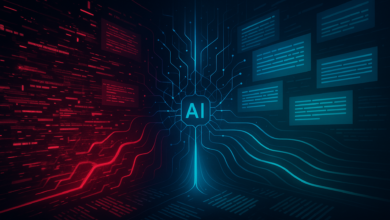Manus vs. ChatGPT: Best AI for Enterprise Data Visualization?

▼ Summary
– Manus.im’s new AI feature quickly transforms messy CSV files into interactive charts, but lacks transparency in data transformations, making it unreliable for enterprise use.
– Many enterprises still rely heavily on spreadsheets for analytics, creating a “last-mile data problem” between data warehouses and CSV exports.
– Manus outperforms ChatGPT in handling corrupted data but is slower, while ChatGPT prioritizes speed over accuracy, leading to misleading visualizations.
– Warehouse-native AI solutions like Google’s Gemini and Microsoft’s Copilot offer better security and lineage tracking by integrating directly with enterprise data infrastructure.
– Manus lacks critical enterprise features like live data connectivity, audit trails, and customizable exports, making it unsuitable for regulated industries despite its technical capabilities.
Enterprise data visualization is undergoing a revolution, with AI tools promising to transform messy spreadsheets into boardroom-ready insights in minutes. Among the contenders, Manus.im has emerged with a specialized solution for handling corrupted datasets, but how does it stack up against general-purpose tools like ChatGPT for business-critical analytics?
A persistent challenge plagues corporate analytics teams: despite investments in BI platforms, nearly 90% of organizations still rely on spreadsheets for last-minute reporting. This creates a gap between governed data warehouses and the ad-hoc CSVs analysts scramble to prepare before meetings. Manus aims to bridge this divide by letting users upload raw files, describe their needs in plain language, and receive polished charts without manual cleanup.
Testing reveals strengths and limitations when comparing Manus to ChatGPT’s Advanced Data Analysis. Using datasets with injected errors, null values, mixed-date formats, and duplicates, Manus proved four times slower but significantly more accurate. For instance, when asked to visualize monthly revenue trends from a corrupted 113k-row e-commerce file, Manus took nearly four minutes but delivered a coherent chart. ChatGPT, while faster (under a minute), produced misleading visuals by skipping critical data cleaning steps.
However, neither tool meets enterprise-grade standards for executive presentations. Charts lacked proper labeling, scaling, and formatting without additional tweaks. More critically, Manus offers no transparency into its data transformations, a red flag for regulated industries. Auditors can’t verify how outliers or duplicates were handled, leaving CFOs vulnerable to unanswerable questions during reviews. In contrast, ChatGPT and rivals like Claude expose their underlying code, though this requires technical expertise to interpret.
Warehouse-native alternatives are pulling ahead. Platforms like Google’s Gemini in BigQuery and Microsoft’s Copilot in Fabric now integrate AI visualization directly into data pipelines, eliminating risky CSV exports. These tools respect existing security models and provide full lineage tracking, features Manus can’t yet match with its file-upload approach.
Key hurdles remain for broader adoption:
- No live data connectors to platforms like Snowflake or BigQuery
- Missing audit trails documenting automated data cleaning
- Limited export options, currently restricted to static PNGs
For small businesses, Manus delivers undeniable value by slashing hours of manual cleanup. But enterprises with complex governance needs should prioritize solutions embedded within their data infrastructure. Until AI tools offer end-to-end transparency and direct warehouse integration, spreadsheets will remain the reluctant hero of quarterly reports. The takeaway? Speed and polish aren’t enough, trust demands visibility.
(Source: VentureBeat)





